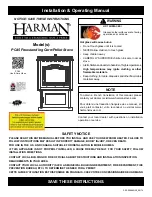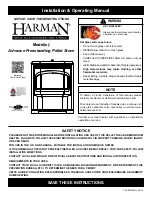
37
IMPORTANT!
READ
AND
FOLLOW
ALL
INSTALLATION
AND
MAINTENANCE
INSTRUCTIONS,
INCLUDING
CLEANING
THE
UNIT
AS
SPECIFIED,
AND
REPLACING
GASKETS
ANNUALLY,
AND
PARTS
AS
NEEDED.
ENGLAND’S
STOVE
WORKS
IS
NOT
RESPONSIBLE
FOR
ANY
DAMAGE
OR
INJURY
INCURRED
DUE
TO
NEGLECT,
OR
DUE
TO
UNSAFE
INSTALLATION
OR
USAGE
OF
THIS
PRODUCT.
CALL
TECHNICAL
SUPPORT
WITH
ANY
QUESTIONS.
that
has
built
up
on
the
fan
blades
can
usually
be
easily
removed
with
a
vacuum
or
a
soft
paint
brush.
Remove
(4)
5
/
16
”
screws
that
hold
the
bracket
in
place
to
remove
the
blower.
YEARLY
MAINTENANCE
Cleaning
Pellet
Fines
from
the
Hopper
and
Auger
Depending
on
the
type
and
quality
of
pellets
burned
in
the
stove,
some
accumulation
of
pellet
fines
and
dust
is
possible
in
the
hopper.
The
lowest
part
of
the
auger,
near
the
back
of
the
stove,
is
where
most
fines
will
accumulate.
With
the
stove
off,
unplugged
,
completely
cool
and
with
the
hopper
empty,
use
a
utility
vacuum
to
remove
the
fines
from
the
auger
tube.
If
the
fines
cannot
be
removed
from
the
top
of
the
hopper:
Remove
the
back
panel,
using
a
5
/
16
”
socket
to
remove
the
screws.
Locate
the
auger
motor
assembly
at
the
middle
rear
of
the
stove,
and
once
it
is
found,
find
the
two
set
screws
on
either
side
of
the
cast
iron
mounting
collar.
Using
a
1
/
8
”
allen
wrench,
loosen
the
set
screw
on
either
side
of
the
auger
mounting
collar.
With
a
utility
vacuum
in
hand,
let
the
auger
assembly
slide
out
of
the
auger
tube
just
enough
so
that
the
vacuum
can
be
used
to
remove
any
fines
from
this
area.
Reinstall
the
auger
assembly
and
tighten
the
two
set
screws;
reinstall
the
back
panel,
being
certain
to
tighten
the
retaining
screws
on
the
rear
of
the
stove.
Cleaning
Pellet
Fines
Inside
Auger
Tube
Remove
the
auger
cover
plate
(located
above
the
auger
at
the
bottom
of
the
hopper)
by
removing
the
(8)
5/16”
screws
that
hold
it
in
place.
Using
a
utility
vacuum
remove
any
excess
dust
or
fines
that
have
collected
in
the
auger
tube
around
the
auger.
Re
‐
install
auger
cover
plate
in
reverse
method.
Checking
Gaskets
An
airtight
seal
at
the
door
opening
is
crucial
to
proper
stove
performance.
Any
air
leaks
in
this
area
can
not
only
cause
a
dirty,
inefficient
burn
but
can
also
pose
a
serious
safety
threat.
Because
of
this,
the
door
gasket
should
always
be
maintained
in
good
condition,
and
replaced
annually
or
sooner
if
necessary.
Gasket
tightness
can
be
checked
using
the
“dollar
‐
bill”
method:
Place
a
dollar
bill
between
the
gasket
and
the
stove
body
(at
the
location
where
the
gasket
meets
the
stove).
Close
the
door
tightly
and
attempt
to
pull
the
dollar
bill
out.
If
the
dollar
bill
slides
in
and
out
easily,
the
gasket
needs
to
be
replaced.
This
test
should
be
repeated
around
the
entire
gasket
perimeter,
as
gaskets
will
sometimes
seal
tightly
on
one
side,
but
will
be
worn
and
seal
poorly
on
another
side.
















































